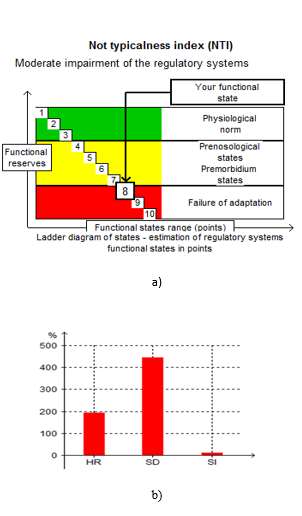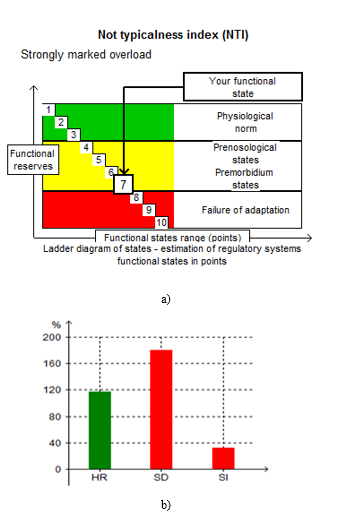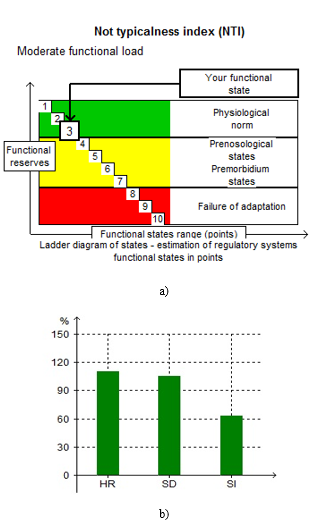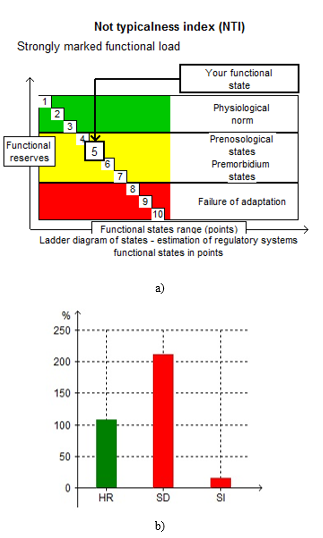Abstract
Currently, the sports community pays little attention to research in rowing. Also, in modern research, insufficient attention is paid to the development and features of the use of special complexes of physical exercises for the development of speed and spatio-temporal properties of rowing athletes. This suggests that we must on the need for athletes to develop orientation in space, including for choosing the right tactics for sports competitions of rowing. It is also important to study the influence of the functional class of athletes in the training process, including comprehending the importance and the possibility of surpassing, during special training, the “basic” normal psychophysiological indicators in a training session. The article reveals the features of the use of a special complex of physical exercises for the development of speed and spatio-temporal properties of rowing athletes. Attention is focused on the need for orientation in the space of athletes in order to choose the right tactics for sports competitions of rowing. The values of the functional class of athletes in the training process are shown. The significance of psychophysiological indicators in a training session is disclosed.
Keywords: Functional classrowingspatio-temporal propertiesspeed
Introduction
Currently, the sports community pays little attention to research in rowing. Rowing is a cyclic sport on special sports courts - narrow (single boat 30 cm wide, eight 60 cm wide) boats with oarlocks (extended overboard) and movable banks (seats) (Ageev, 2012; Fletcher, 2015; Krasotkina, 2015; Yakovlev et al., 2018). Now the scientists must focus on the need for athletes to develop orientation in space, including for choosing the right tactics for sports competitions of rowing. It is also important to study the influence of the functional class of athletes in the training process, including comprehending the importance and the possibility of surpassing, during special training, the “basic” normal psychophysiological indicators in a training session (Arshinova et al., 2019; Hackfort et al., 2019; May, 2010; Raab et al., 2016; Sarkar & Marcora, 2018; Serova & Narkhov, 2016; Trimpop, 1994).
The modern level of sports achievements in rowing requires continuous improvement of techniques in the preparation of rowers (Danish et al., 2005; Duda & Treasure, 2006; Goodger et al., 2007; Goodwin, 2009; Jowett, 2014; Marchant, 2010; Nahum, 2017; Van Raalte & Brewer, 2010; Wagstaff, 2019a, 2019b; Weinberg & Gould, 2010).The development of speed in the holistic process of sports improvement of rowers is one of the relevant topics in the physical training of rowers (Ageev, 2012; Bayer & Sheinberg, 2016). Despite the relevance of the issue under study, the problem of the development of speed in relation to the training of young athletes has not yet received sufficient scientific justification (Bayer & Sheinberg, 2016; Gavrilova, 2015; Yakovlev et al., 2018). It should be noted that in most works, orientation toward models is positively considered when solving problems of versatile physical preparation, however, specific programs of directed training influence to achieve the proper level in the development of speed are not enough. Therefore, this topic is relevant (Bayer & Sheinberg, 2016; Ivanchikova et al., 2014; Yakovlev et al., 2018).
Problem Statement
In modern research, insufficient attention is paid to the development and features of the use of special complexes of physical exercises for the development of speed and spatio-temporal properties of rowing athletes. This suggests that we must focus on the need for athletes to develop orientation in space, including for choosing the right tactics for sports competitions of rowing. It is also important to study the influence of the functional class of athletes in the training process, including comprehending the importance and the possibility of surpassing, during special training, the “basic” normal psychophysiological indicators in a training session.
Research Questions
Tasks of the study:
To study the level of development of speed and spatio-temporal properties of rowing.
Develop complexes for the development of speed and spatio-temporal properties.
Determine the effectiveness of the proposed complexes.
Purpose of the Study
The purpose of the research is to study the process of development of high-speed and spatio-temporal properties of athletes.
Research Methods
The training process in the initial training group included classes in the gym, rowing pool and on the water. The duration of one lesson ranged from 1 hour to 2 hours. Training sessions were built on the individualization and consideration of the age characteristics of athletes. During the study, athletes were tested on the following indicators:
Tests to determine the level of speed: shuttle run 4x10 meters (sec), run 100 meters (sec), lift the body from a supine position in 30 seconds (number), jump rope for 30 seconds (number of times), jumping onto the pedestal (number of times), rowing 500 meters (sec).
Tests for determining the spatial and temporal properties of a person: determining the reaction time of a choice, estimating the angular velocity of movement, determining the reaction time to a moving object (RMO).
The program "Researcher of temporal and spatial properties of man" (Koryagina & Nopin, 2004; Koryagina et al., 2015; Nopin & Koryagina, 2003).
The study of the functional class, based on the apparatus of “Varicard 2.51”.
Hardware-software complex "Varicard 2.51". For the analysis of HRV, the “Varicard 2.51” hardware-software complex was used, which allows calculating up to 40 different parameters recommended by both Russian and European-American standards (Semenov & Bayevskiy, 1996).
Based on pedagogical observation and individual conversations with the rowing trainer, 20 rowers were selected. Children were divided into two different groups: a control group (CG) of 10 people and an experimental group (EG). The main difference between the EG and the CG was the use in the EG of a special set of physical exercises for the development of speed and spatio-temporal properties among rowing. In the CG, training sessions were held according to the standard program.
The study was conducted in Tolyatti from September 2019 to May 2020 in limited liability company (LLC) “Samara Regional Rowing Federation” and was divided into three stages.
At the first stage (September 2019), the scientific and methodological literature on the problem of this study was studied, as a result of which the object and subject, purpose, main tasks and research methods were determined. At this stage, we determined the age of children who do not have contraindications for classes based on an analysis of medical records and doctor's recommendations. Before conducting the pedagogical experiment, an initial test was organized, which made it possible to assess the functional state, spatial and temporal properties of the rowers' personality, the level of development of speed and the state of health of the experimental and control groups.
At the second stage (October - April 2020), a pedagogical experiment was conducted in which two groups of students participated: experimental (EG) included 10 rowers of academicians, and control group (CG) included 10 rowers of academicians. All participants in the pedagogical experiment were aged 10-12 years.
At the third stage, in May 2020, repeated testing was carried out in order to determine the influence of the developed methodology on the development of speed and spatio-temporal properties of athletes in both the EG and the CG. Static data processing was used to process the test results that were carried out before and after the pedagogical experiment. Using the STAT computer program, the following quantities were found: M — is arithmetic mean; δ – is squared deviation; m - is the arithmetic mean error. To test the hypothesis of the difference between the two-arithmetic means, Student t-test was used. The results were considered reliable at a 5% significance level.
Findings
At the first stage of the study, both groups were tested for all proposed tests to assess speed. The results are shown in Table
The results at the beginning of the study indicate that the level of development of speed in both groups is the same and does not have significant differences. In addition, the results of a stating experiment showed that the groups were selected correctly. Then, at the first stage of the pedagogical experiment, tests were conducted to study the spatio-temporal properties of the personality of rowing. The results are presented in Tables
RMO test scores in both groups are at the same level - average. RMO is used to determine the relationship between the processes of excitation and inhibition in the cerebral cortex.
An important characteristic of the processes of perception of time and space of the driver is the assessment of speed. This test allows you to evaluate the angular velocity of the object. The test results for both groups are approximately the same; this indicates the groups correctly selected for the pedagogical experiment.
The reaction time of choice is one of the options for a complex sensorimotor reaction since it is necessary to differentiate the signal (one signal must be reacted to, but not the other). This leads to an increase in response time due to the “central delay”, to recall how exactly one should respond to a particular signal. The data obtained during testing showed that there are no significant discrepancies in the indicators, therefore, the honey groups are equal.

The definition of the functional class was carried out using the “Varikard 2.51” firmware. ‘Figure

When testing the CG, it was found that athletes have 7 functional class and are in a pre-nosological state (Figure
Thus, testing of CG and EG at the beginning of the study showed that both groups are approximately at the same level in all indicators and tests. In the study of the functional class, it was found that athletes are tired and it is necessary to adjust the training process.
The following TFP exercises in the boat were included in the classes of the experimental group:; hand grip; rowing without turning the blades; rowing 500 meters; rowing 2 minutes at a fast pace - 2 minutes at a low pace; starting strokes; rowing 250 meters; rowing with arms torn behind the knees; rowing with arms torn off in front of the knees; rowing with one hand; rowing hands and body. The creature included such training sessions for developing speed as running training, circular training 30 seconds of work - 30 seconds of rest, jumping training, exercises with weights, exercises on the Concept 2 rowing machine. After applying a special set of physical exercises, the EG and KG were again tested for the level of development of speed (Table
Analysing the data obtained as a result of a pedagogical experiment in the test “Shuttle 4x10 meters”, we found that the EG indicators significantly exceed the control group by 2.3 seconds. During the study in the test "Shuttle 4x10 meters, s." The EG improved its performance by 3 seconds and the control group by 0.8 seconds. As Table
According to the results of Table
Comparing the results of Table
Examining the CG and EG after repeated testing in the test “Jumping rope for 30 seconds, number of times”, we see that in the EG athletes improved their performance by 19.3 times, increasing the result from 70.8 times to 90.1 times. In the CG the growth was minimal and amounted to only 3.2 times, changing the indicators from 73.6 to 79.8 times. Comparing the obtained data, we see that the obtained results are reliable, since p <0.05.
The analysis of the data obtained from Table
A comparison of the results of the two groups is shown in Table
According to the results of the pedagogical experiment, it was found that with the systematic application of our proposed methodology, significant changes occurred in the EG, which cannot be said about the CG. The EG improved its performance in all the proposed tests; in the CG, the increase was insignificant.
At this stage of the study, the spatio-temporal properties of rowing were again tested. Table
Testing the estimate of the angular velocity of movement at the end of the study shows that the EG improved and has a high rating, while in the CG the numerical increase was insignificant, but an average estimate of the angular velocity of motion was established. Thus, the data obtained after repeated testing indicate that our proposed methodology is very effective and favorably affects the development of spatio-temporal properties of rowing.
Comparing the data obtained because of repeated testing, we see that the EG improved reaction rates, which increased the level from medium to high. In the CG, the average level remained (Table
In the EG, the result of determining the response time of the choice improved by 0.13 seconds, showing a high level of reaction, while the CG by 0.6 seconds. As Table
At the end, both study groups were tested on a “Varicard 2.51” apparatus in order to determine the functional class. EG results are shown in Figure

Analyzing the data obtained during the repeated study and comparing them with the previously obtained results, we found that the EG from the 8th functional class moved to 3. The 3rd functional class is the physiological norm, which means that the EG athletes do not experience health problems and are ready to show the high result in the competition. An optimal functional state is observed.
Figure

In the CG, athletes were not able to get out of the yellow zone, as they showed the 5th functional class, which means the pre-nosological state of STI. As a result of the pedagogical experiment, the CG from the 7th functional class rose to 5. Based on the data obtained, we conclude that athletes of this group have reduced adaptive capabilities. Thus, the study of the functional class in the CG and the EG showed that with the systematic use of special physical exercises, the functional class will be in the zone of the physiological norm in the EG. The CG was not able to get out of the pre-nosological state during systematic studies according to the generally accepted training program.
Conclusion
-
At the beginning of the study, both study groups had an approximately equal level of development of speed. Because of classes using the proposed methodology, the EG improved its performance and exceeded the CG in all the proposed tests.
-
In the study of spatio-temporal properties, the best values were established for the proposed tests in the EG, in contrast to the CG. The results are significant p <0.05
-
During the study, the functional class of the EG stabilized and entered the physiological norm zone; in the CG, athletes did not leave the zone of the pre-nosological state.
References
- Ageev, Sh. K. (2012). The main aspects of the Modern system of training qualified athletes in rowing. Volga State Academy of Physical Culture, Sports and Tourism Publ.
- Arshinova, V. V., Arpentieva, M. R., Kuznetsova, N. V., & Novakov, A. V. (2019). Questions of psychological support in sports, recreational, health and medical practices. Physical Culture. Sport. Tourism. Motor recreation, 4(1), 106-114.
- Bayer, K., & Sheinberg, L. (2016). Healthy lifestyle. Mir publ.
- Danish, S. J., Forneris, T., & Wallace, I. (2005). "Sport-based life skills programming in the schools". Journal of Applied School Psychology, 21(2), 41–62. https://doi.org/10.1300/j370v21n02_04
- Duda, J. L., & Treasure, D. C. (2006). Motivational processes and the facilitation of performance, persistence, and well-being in sport. In J. M. Williams (Ed.). Applied Sport Psychology: Personal Growth to Peak Performance (pp. 57-81). McGraw-Hill.
- Fletcher, E. (2015). Medical Guide. Diagnosis and therapy. Mir publ.
- Gavrilova, E. A. (2015). Sport, stress, variability. Sport Publ.
- Goodger, K., Gorely, T., Lavallee, D., & Harwood, C. (2007). Burnout in sport: A systematic review. The Sport Psychologist, 21, 127–151. https://doi.org/10.1123/tsp.21.2.127
- Goodwin, C. J. (2009). E. W. Scripture: The application of "new psychology" methodology to athletics. In C. D. Green & L. T. Benjamin (Eds.), Psychology gets in the game (pp. 78-97). University of Nebraska Press.
- Hackfort, D., Schinke, R., & Strauss, B. (Eds.) (2019). Dictionary of Sport Psychology. Academic Press.
- Ivanchikova, N. N., Nekhvyadovich, A. I., & Budko, A. N. (2014). An integrated approach to the diagnosis of functional status of highly qualified athletes. Science and sport: current trends, 4, 79-83.
- Jowett, S. (2014). Interdependence Theory and Coach-Athlete Relationships. In R. Eklund & G. Tenenbaum (Eds.), Sage Encyclopedia of Sport and Exercise Psychology. Sage.
- Koryagina, Yu. V., & Nopin, S. V. (2004). Researcher of temporal and spatial properties of man No. 2004610221. Computer programs (official bulletin), 2(47), 51.
- Koryagina, Yu. V., Nopin, S. V., Blinov, V. A., & Blinov, O. A. (2015). Technology "EXERGAMES" as an innovative means of sports training and testing the performance of athletes (based on foreign literature). P.F. Lesgaft Scientific notes of the University, 7, 113-119.
- Krasotkina, I. N. (2015). Biorhythms and health. Series: Healthy Lifestyle. Peter Publ.
- Marchant, D. B. (2010). Psychological assessment: Objective/self-report measures. In Hanrahan, S. J. & Andersen, M. B. (Eds.), Routledge handbook of applied sport psychology (pp. 111-119). Routledge.
- May, R. K. (2010). Sport Psychology. The Corsini Encyclopedia of Psychology, American Cancer Society, 1–2. https://doi.org/10.1002/9780470479216.corpsy0937
- Nahum, O. (2017). Stress research in sport psychology: Three limitations and future directions. Logos.
- Nopin, S. V., & Koryagina, Yu. V. (2003). Development of software for the study of sports abilities (for example, the computer program "Researcher of temporal and spatial properties of man"). Omsk Scientific Herald, 4, 196–197.
- Raab, M., Wylleman, P., Seiler, R., Elbe, A.-M., & Hatzigeorgiadis, A. (Eds.). (2016). Sport and Exercise Psychology Research. Academic Press.
- Sarkar, M., & Marcora, S. (Eds.). (2018). Sport and the Brain: The Science of Preparing, Enduring and Winning. In Progress in Braine Research, Part C, 240 (pp. 1- 392). Academic Press,
- Semenov, Yu. H., & Bayevskiy, R. M. (1996). Hardware-software complex "Varicard" for assessing the functional state of the body according to the results of a mathematical analysis of the heart rhythm. In Heart rate variability (pp. 160–162). Udmurt State University.
- Serova, N., & Narkhov, D.Yu. (Eds.) (2016). Actual problems of physical education and sport in educational organizations: proceedings of the all Russia scientific-practical Conference with international participation (Ekaterinburg, December 11, 2015). Ural University.
- Trimpop, R. M. (1994). The Psychology of Risk-Taking Behaviour. Advances in Psychology, 107, 1-416. North Holland Publ.
- Van Raalte, J. L., & Brewer, B. W. (2010). Sport Performance Interventions. The Corsini Encyclopedia of Psychology, American Cancer Society, 1–3. https://doi.org/10.1002/9780470479216.corpsy0936
- Wagstaff, Ch. R. D. (2019a). Taking Stock of Organizational Psychology in Sport. Journal of Applied Sport Psychology, 31, 1–6. https://doi.org/10.1080/10413200.2018.1539785
- Wagstaff, Ch. R. D. (2019b). A Commentary and Reflections on the Field of Organizational Sport Psychology. Journal of Applied Sport Psychology, 31, 134–146. https://doi.org/10.1080/10413200.2018.1539885
- Weinberg, R. S., & Gould, D. (2010). Foundations of Sport and Exercise Psychology. Human Kinetics.
- Yakovlev, A. N., Makarina O. M., & Glushenko N. A. (2018). The structure of the construction of educational activities in cyclic sports (for example, rowing). Physical education and sports training, 2, 73-80.
Copyright information

This work is licensed under a Creative Commons Attribution-NonCommercial-NoDerivatives 4.0 International License.
About this article
Publication Date
28 December 2020
Article Doi
eBook ISBN
978-1-80296-098-3
Publisher
European Publisher
Volume
99
Print ISBN (optional)
-
Edition Number
1st Edition
Pages
1-1040
Subjects
Multicultural context, learning environment, modern society, personality formation, informatization of the society, economics and law system of the region
Cite this article as:
Lunkova, E. V., Gorelik, V. V., Khorosheva, T. A., Podlubnaya, A. A., & Demeshev, I. G. (2020). Features Of The Training Sessions Of Rowing At The Beginning Of Preparation. In N. L. Shamne, S. Cindori, E. Y. Malushko, O. Larouk, & V. G. Lizunkov (Eds.), Individual and Society in the Modern Geopolitical Environment, vol 99. European Proceedings of Social and Behavioural Sciences (pp. 579-591). European Publisher. https://doi.org/10.15405/epsbs.2020.12.04.67

